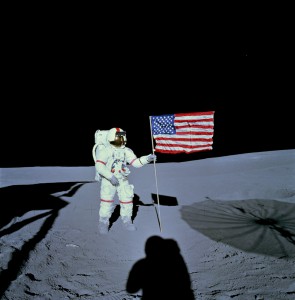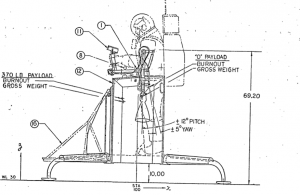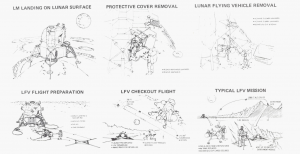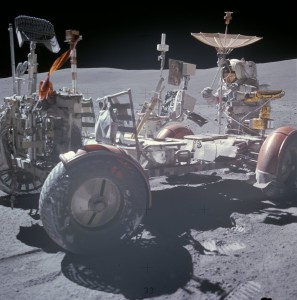We Almost Had Jet Packs on the Moon
Posted on Categories Discover Magazine

The Apollo lunar landing missions had limitations. The personal life support system backpacks moonwalking astronauts wore didn’t have replenishing stores of consumables. Once their power and oxygen supplies were low, there was no choice but to return to the lunar module, which itself could only support two men for three days. But in early 1969 NASA was already thinking ahead to longer duration missions, and to get the most out of these lunar stays, the agency commissioned two studies into possible personal flying units that astronauts could use to cover more lunar ground. Yes, for a brief moment NASA was considering sending astronauts with jet packs to the Moon.
The Need for Lunar Jet Packs
In the early and mid 1960s, there was some interest in giving lunar astronauts personal flying devices to help them be more mobile on the Moon’s surface. This was also a time when very little was known about the lunar environment. Not until the Surveyor probes landed did NASA learn, for example, that the surface dust layer was not waist deep. With more information the lunar missions were planned with astronauts covering the area around their landing site on foot.
Then in the summer of 1967, interest in these kinds of mobility aids gained a boost. NASA’s Manned Spacecraft Centre in Houston held a Study of Lunar Science and Exploration at the University of California in Santa Cruz, and one of the topics on the roster was how to expand an astronaut’s abilities during a relatively short lunar stay. The ensuing report was in no way an official NASA program, but it did get the science community thinking. Attending scientists recognized that the first landing missions couldn’t really take on more than completing the landing goal with astronauts covering an area just over a half mile (about one kilometer) from the LM. But on later missions when the business of landing on the Moon was old hat and geological sampling took precedence, personal flying units could seriously enhance the science return. If astronauts could cover more distance in less time and even visit sites high up on crater walls or mountains, we could learn that much more about the Moon.
And so the report recommended that NASA consider developing personal flying for astronauts on those later missions.
It wasn’t until two years later in early 1969 that NASA followed up on that recommendation. In January of 1969 with the first lunar landing attempt imminent, the agency issued two Lunar Flying Unit study contracts, one to Bell Aerosystems and one to North American Rockwell. Five months later both companies presented their bids to NASA, each hoping to be the first to fly astronauts on the Moon.
 Bell’s One Man Lunar Flying Vehicle
Bell’s One Man Lunar Flying Vehicle
This wasn’t the first time Bell had worked on flying units. Not only had it developed some systems with NASA earlier, it was also the company behind the Rocket Belt Hydrogen Peroxide Propulsion System. More simply called the rocket belt, this was a wearable jet pack that provide 300 pounds thrust and had made more than 3,000 successful demonstration flights. Building off this previous experience, Bell developed its one man lunar flying unit.
Rather than a wearable device, Bell proposed a system with the astronaut standing on a platform that was raised off the lunar surface by four legs ending, like the lunar module’s, in rounded footpads. And because he was standing, the astronaut’s own legs acted as shock absorbers, meaning the flyers legs could be kept simple, static, and lightweight. To keep him from falling off the platform there was a safety strap as well as two handlebar-like handles he could grip on a sort of console, which also doubled as his flight controls. They were similar to the handle controls in the LM, and the commands he input through moving the handles fed to the two throttleable engines mounted on either side of the console that generated between 50 and 300 pounds of thrust.
As per NASA’s guidelines in the study contracts, the fuel tanks feeding those engines would be filled from excess hypergolic propellant in the lunar module’s descent stage. Grumman, the contractor who built the LM, estimated that anywhere between 300 and 1,500 pounds of propellants would be left in the tanks after touchdown, so hoses could facilitate the fuel transfer. With the full flying unit holding 300 pounds of fuel, an astronaut and his lunar EVA suit, and about 100 pounds of payload, the whole system would weigh 1,000 pounds. In the Moon’s lower gravity environment, that was light enough to fly easily without huge amounts of thrust.
To get that flyer to the Moon, Bell proposed folding it in such a way that it could fit safely into one of the storage bays in the LM’s descent stage and set up simply after landing. But it wouldn’t be the only one. An ideal scenario, according to Bell, was to have two of these flying units on each mission, one for actual exploration of distant sites and the other reserved as an emergency rescue vehicle. If some technical malfunction left one astronaut stranded, the other could fly out to get him. Adding a palette to the flyer would allow it to carry two men.
The system Bell outlined in its proposal was made with modifications in mind. The engines, overall structure, and legs were all designed to accommodate a version up to 25 percent heavier on future missions. The same system could even be modified to facilitate future astronauts’ exploration of Mars. Bell even looked at versions that could serve as rescue vehicles if the LM’s ascent engine failed. The smaller, one-man flyer configuration, for example, could take him into orbit with the addition of 500 pounds of fuel and two 150-pound thrust engines.
Bell put the total cost of development — including non-recurring and program management as well as recurring costs of building 16 vehicles — at 29.2 million in 1969. With that level of funding, the system could be operational as early as 1973.
North American Rockwell’s One Man Lunar Flying Vehicle
North American Rockwell didn’t have the same background in jet packs as Bell, but it was familiar with the space game. Before it merged with Rockwell International, North American Aviation had won the contracts to build the Apollo command-service module and the S-II second stage of the Saturn V rocket, contracts that carried over through the merger in 1967.
 Like Bell’s proposal, NAR’s flyer used a platform as the base and four legs for stability at the moment of touchdown and take off. Also like Bell’s, NAR’s flyer was designed to fold into an LM storage bay for transfer to the Moon and fly using leftover propellant from the LM’s descent stage. But that’s where the similarities ended.
Like Bell’s proposal, NAR’s flyer used a platform as the base and four legs for stability at the moment of touchdown and take off. Also like Bell’s, NAR’s flyer was designed to fold into an LM storage bay for transfer to the Moon and fly using leftover propellant from the LM’s descent stage. But that’s where the similarities ended.
Propulsion in NAR’s design came from four engines clustered together at the vehicle’s centre of gravity, each of which generated 105 pounds of thrust. Right above that cluster was the astronaut’s seat. All this added to stability in flight. Not only was the centre of gravity low to the ground the clustered engines offered redundancy; the vehicle could still fly if it lost one engine. But because the astronaut was seated his legs couldn’t act as shock absorbers, meaning the flyer’s legs had to have the appropriate hardware to protect him from a jolt on landing. This added weight. All told — fueled and carrying a suited astronaut and the NASA-mandated 100 pounds of cargo — it weighed about 1,075 pounds. But again, this was fine in the Moon’s lower gravity environment.
The low engines created another problem. Because they were so low to the ground there was a risk that exhaust would kick up dust and rocks, potentially damaging the flyer enough to put it out of commission. NAR’s solution was to have the flyer takeoff from a special fabric launch pad 40 feet from the LM. The astronaut would lay out this blanket, pull the flyer on top of it, then launch. Of course there would be no prepared landing blankets at the remote sites, so NAR’s solution was the have the astronaut cut the engines about 58 inches above the surface. Between lower gravity and shock absorbers on the legs, the astronaut would be fine. And he’d have expendable launch blankets with him to make sure no debris threatened his takeoff back towards the LM.
NAR’s proposal didn’t offer any of the Martian spin-off or rescue versions Bell’s had. Its selling point was instead on vertical range. Bell’s system topped out under 100 feet but NAR’s could reach 2,000 feet, offering NASA the chance to send astronauts to interesting and remote locations on hillsides and crater walls while still keeping them close enough to walk back the LM in an emergency.
 Cars > Jets
Cars > Jets
As we know there were no flying platforms on the Moon. NASA decided that wheels were best for expanding the astronauts’ surface abilities and in October of 1969 contracted Boeing to build a lightweight vehicle astronauts could drive on the Moon. This became the Apollo Lunar Roving Vehicle, and its impact was significant. On Apollos 11, 12, and 14, crews covered a total combined distance of 4.4 miles. With a rover, Apollo 15 covered 17 miles and Apollo 16 covered 16.8 miles. On the last mission, Apollo 17’s Gene Cernan and Jack Schmitt drove the furthest from the LM — 4.5 miles away — and covered a total of 22.2 miles.
It wasn’t a rocket powered flying unit, but the rover ultimately solved the problem of limited EVA abilities for Apollo.
TL;DR version:
Sources: Study of a One Man Lunar Flying Vehicle, NAR, 1969; 1967 Summer Study of Lunar Science and Exploration, NASA; Study of One Man Flying Vehicle, Bell Aerosystems Co., 1969; Apollo Advanced Lunar Exploration Planning, Robert Godwin ed., Apogee Books.